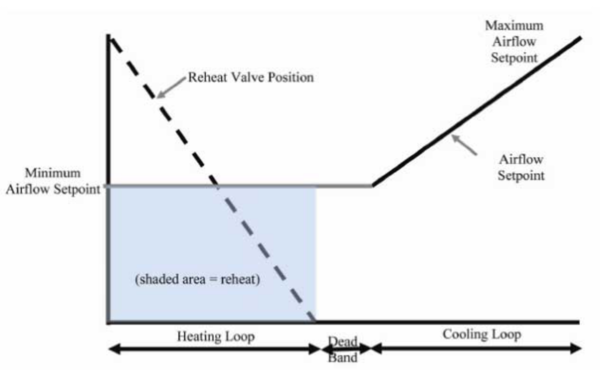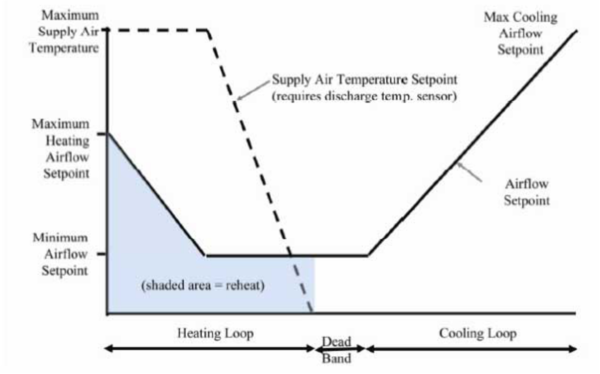First time here? Check out the Help page!
 | 1 | initial version |
I'm not sure there is a way to set the particular control sequence you describe. In a typical system, you'd open the hot water valve and ramp up the supply air temperature before increasing airflow as you show in your image.
To set up this control, use the Damper Heating Action on your VAV:Reheat object. Documentation here.
Single-Max defaults, corresponding to Normal Damper Heating Action, are typical for older systems.

"With Normal action, the damper will remain at the minimum air flow rate during heating operation. As the heating load increases, the water flow rate in the reheat coil will be increased to maintain temperature in the zone until the maximum water flow rate is reached or the user-specified maximum reheat air temperature is reached. This is sometimes called the single maximum control logic as illustrated below."
ReverseWithLimits represents Dual-Max control that is the standard as of T24-2008 and an addendum to ASHRAE 90.1-2010, detailed in a 2012 ASHRAE Journal article (by Taylor Engineering, of course). Typical defaults for this are to set Maximum Flow Fraction During Reheat to 0.5.

"With Reverse and ReverseWithLimits (the default) action, as the heating load increases, the unit starts at minimum air flow and minimum hot water flow. The hot water flow is increased until it reaches maximum flow or the user-specified maximum reheat air temperature is reached, then the air damper starts to open to meet the load. For Reverse the damper can open all the way. For ReverseWithLimits the damper can only partially open to a maximum flow rate given by the following two fields. These options are used if the minimum air flow rate is not adequate to serve the peak heating load. This is sometimes called the dual maximum control logic as illustrated in following figure. For heating coil types other than the hot-water coil, e.g. electric, steam, and gas, the reverse action works the same as the normal action – always keeping the air flow at the minimum during heating."
I don't think there is a way you can explicitly set the the temperatures below the deband that correspond to a 50% or 100% heating loop signal, which is what you'd do in actual control logic. EnergyPlus will just respond to meet the load, and increase airflow if it needs to.
While 95°F reheat max temperature is typical for VAV reheat systems, more recently, 90.1-2016 requires that the maximum supply air temperature is less than 20°F above space temperature setpoint, or about 90°F with a 70°F setpoint, and ASHRAE Guideline 36: High Performance Sequences of Operation for HVAC Systems recommends a max of 15°F above space temperature setpoint to further limit stratification. G36 uses Dual-Max control for VAV reheat, though instead of a maximum discharge air temperature, it defines it as a maximum delta above space temperature setpoint.
 | 2 | No.2 Revision |
I'm not sure there is a way to set the particular control sequence you describe. In a typical system, you'd open the hot water valve and ramp up the supply air temperature before increasing airflow as you show in your image.
To set up this control, use the Damper Heating Action on your VAV:Reheat object. Documentation here.
Single-Max defaults, corresponding to Normal Damper Heating Action, are typical for older systems.

"With Normal action, the damper will remain at the minimum air flow rate during heating operation. As the heating load increases, the water flow rate in the reheat coil will be increased to maintain temperature in the zone until the maximum water flow rate is reached or the user-specified maximum reheat air temperature is reached. This is sometimes called the single maximum control logic as illustrated below."
ReverseWithLimits represents Dual-Max control that is the standard as of T24-2008 and an addendum to ASHRAE 90.1-2010, detailed in a 2012 ASHRAE Journal article (by Taylor Engineering, of course). Typical defaults for this are to set Maximum Flow Fraction During Reheat to 0.5.

"With Reverse and ReverseWithLimits (the default) action, as the heating load increases, the unit starts at minimum air flow and minimum hot water flow. The hot water flow is increased until it reaches maximum flow or the user-specified maximum reheat air temperature is reached, then the air damper starts to open to meet the load. For Reverse the damper can open all the way. For ReverseWithLimits the damper can only partially open to a maximum flow rate given by the following two fields. These options are used if the minimum air flow rate is not adequate to serve the peak heating load. This is sometimes called the dual maximum control logic as illustrated in following figure. For heating coil types other than the hot-water coil, e.g. electric, steam, and gas, the reverse action works the same as the normal action – always keeping the air flow at the minimum during heating."
I don't think there is a way you can explicitly set the the temperatures below the deband that correspond to a 50% or 100% heating loop signal, which is what you'd do in actual control logic. EnergyPlus will just respond to meet the load, and increase airflow if it needs to.
While 95°F reheat max temperature is typical for VAV reheat systems, more recently, 90.1-2016 requires that the maximum supply air temperature is less than 20°F above space temperature setpoint, or about 90°F with a 70°F setpoint, and ASHRAE Guideline 36: High Performance Sequences of Operation for HVAC Systems recommends a max of 15°F above space temperature setpoint setpoint, typically 85°F, to further limit stratification. G36 uses Dual-Max control for VAV reheat, though instead of a maximum discharge air temperature, it defines it as a maximum delta above space temperature setpoint.
 | 3 | No.3 Revision |
I'm not sure there is a way to set the particular control sequence you describe. In a typical system, you'd open the hot water valve and ramp up the supply air temperature before increasing airflow as you show in your image.
To set up this control, use the Damper Heating Action on your VAV:Reheat object. Documentation here.
Single-Max defaults, corresponding to Normal Damper Heating Action, are typical for older systems.

"With Normal action, the damper will remain at the minimum air flow rate during heating operation. As the heating load increases, the water flow rate in the reheat coil will be increased to maintain temperature in the zone until the maximum water flow rate is reached or the user-specified maximum reheat air temperature is reached. This is sometimes called the single maximum control logic as illustrated below."
ReverseWithLimits represents Dual-Max control that is the standard as of T24-2008 and an addendum to ASHRAE 90.1-2010, detailed in a 2012 ASHRAE Journal article (by Taylor Engineering, of course). Typical defaults for this are to set Maximum Flow Fraction During Reheat to 0.5.

"With Reverse and ReverseWithLimits (the default) action, as the heating load increases, the unit starts at minimum air flow and minimum hot water flow. The hot water flow is increased until it reaches maximum flow or the user-specified maximum reheat air temperature is reached, then the air damper starts to open to meet the load. For Reverse the damper can open all the way. For ReverseWithLimits the damper can only partially open to a maximum flow rate given by the following two fields. These options are used if the minimum air flow rate is not adequate to serve the peak heating load. This is sometimes called the dual maximum control logic as illustrated in following figure. For heating coil types other than the hot-water coil, e.g. electric, steam, and gas, the reverse action works the same as the normal action – always keeping the air flow at the minimum during heating."
I don't think there is a way you can explicitly set the the temperatures below the deband that correspond to a 50% or 100% heating loop signal, which is what you'd do in actual control logic. EnergyPlus will just respond to meet the load, and increase airflow if it needs to.
While 95°F reheat max temperature is typical for VAV reheat systems, more recently, 90.1-2016 requires that the maximum supply air temperature is less than 20°F above space temperature setpoint, or about 90°F with a 70°F setpoint, and ASHRAE Guideline 36: High Performance Sequences of Operation for HVAC Systems recommends a max of 15°F above space temperature setpoint, typically 85°F, to further limit stratification. G36 uses Dual-Max control for VAV reheat, though instead of a maximum discharge air temperature, it defines it as a maximum delta above space temperature setpoint.
